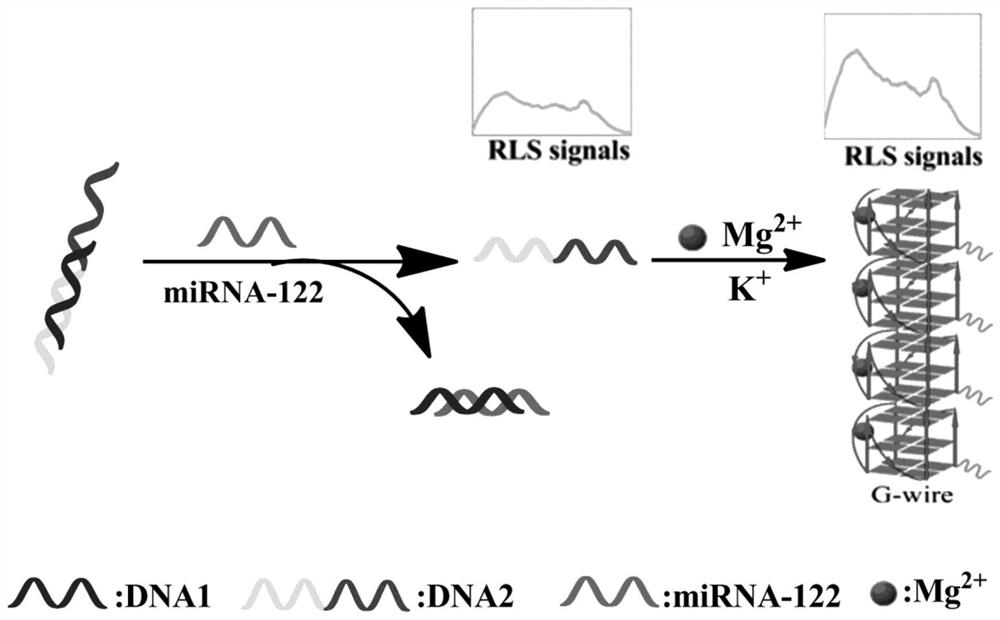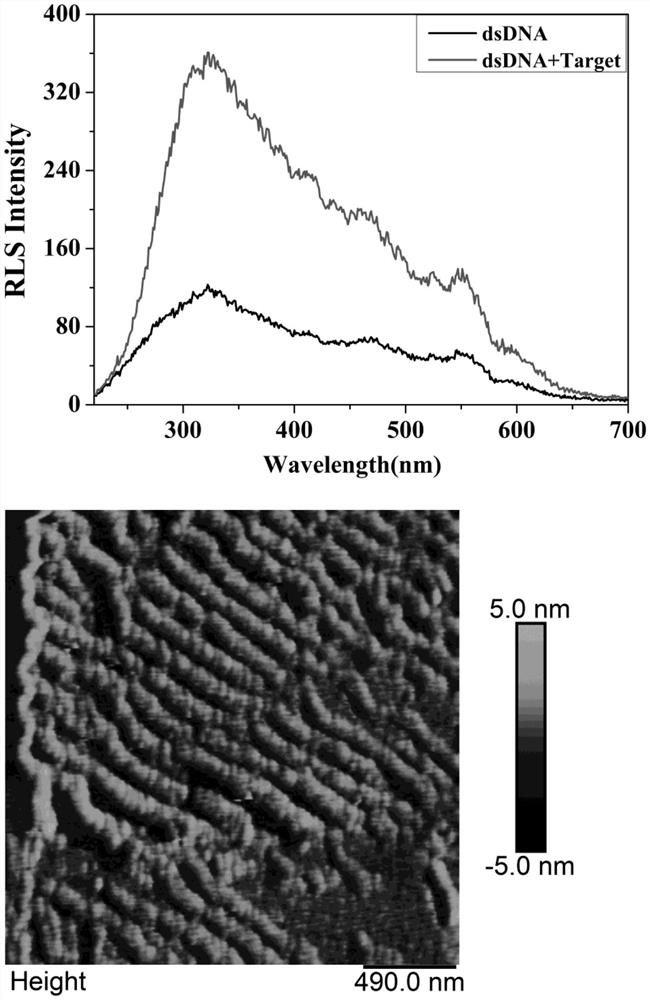A resonant light detection kit and method for detecting miRNA-122 based on a g-wire nanostructure
A miRNA-122, detection kit technology, applied in the measurement of scattering properties and other directions, can solve the problems of expensive design, harsh reaction conditions, complex preparation processes and substrate materials, and achieve good discrimination, simplified detection process, and easy to obtain. Effect
- Summary
- Abstract
- Description
- Claims
- Application Information
AI Technical Summary
Problems solved by technology
Method used
Image
Examples
Embodiment 1
[0033] Feasibility determination of a resonant light detection kit based on G-wire nanostructure in the detection of miRNA-122
[0034] The first group mixed 200 nM DNA1 and DNA2 in a centrifuge tube to obtain double-stranded DNA (dsDNA), then measured its resonance light signal. The second group adds target objects on the basis of the first group, and then measures its resonance optical signal. The result is as image 3 As shown, the resonance light signal was weak when only DNA1 and DNA2 existed, but the resonance light signal was significantly enhanced after adding miRNA-122. The experimental results show that in the absence of miRNA-122, G-wire cannot be formed, and only a weak resonance light signal can be generated. When miRNA-122 was added, DNA2 containing -G-rich sequence was released because miRNA-122 combined with DNA1. The G-rich sequences of DNA2 are capable of folding into parallel G-quadruplexes that can be 2+ Under the action, it further self-assembles into ...
Embodiment 2
[0036] Analysis of optimization conditions of a resonant light detection kit based on G-wire nanostructure in the detection of miRNA-122
[0037] In order to obtain the best detection performance, various factors affecting the detection of miRNA-122 were studied and optimized, including Mg 2+ and K + concentration, reaction time and working temperature. Such as Figure 4 As shown, the resonance light intensity change tended to be stable at 60 min. Therefore, 60 minutes was selected as the most effective reaction time for the combination of DNA1 and miRNA-122. Such as Figure 5 As shown, the highest resonance light intensity change (ΔI RLS =I-I 0 ). Therefore, 37°C was selected as the optimal reaction temperature. Such as Figure 6 As shown, when Mg 2+ Concentration is 200mM and K + When it is 200mM, the resonance light intensity has a maximum value, therefore, the Mg 2+ and K + The concentration was set at 200mM. Such as Figure 7 As shown, with Mg 2+ With the ...
Embodiment 3
[0039] Sensitivity determination of a resonant light detection kit based on G-wire nanostructure in the detection of miRNA-122
[0040] The DNA1 (200nM), DNA2 (200nM) mixture was incubated at 37°C for 40 minutes, then miRNA-122 solutions of different concentrations were added to the mixture, incubated at 37°C for 60 minutes, and then Mg was added to the mixture 2+ (200mM) and K + (200mM) and reacted at 4°C for 2 hours for resonance light detection. Such as Figure 8 As shown, a series of concentrations of miRNA-122 solutions were measured in the range of 50pM to 300nM. The linear regression equation obtained between miRNA-122 and the resonance light intensity is ΔI=1.2981C+32.8620 (R 2 =0.9930) (wherein C is miRNA-122 concentration; ΔI=I-I 0 , where I is the RLS intensity after adding miRNA-122, I 0 is the RLS intensity before adding miRNA-122), and the detection limit of miRNA-122 calculated according to 3σ / k is 6.1pM, indicating that the resonance light detection kit ha...
PUM
 Login to View More
Login to View More Abstract
Description
Claims
Application Information
 Login to View More
Login to View More - R&D
- Intellectual Property
- Life Sciences
- Materials
- Tech Scout
- Unparalleled Data Quality
- Higher Quality Content
- 60% Fewer Hallucinations
Browse by: Latest US Patents, China's latest patents, Technical Efficacy Thesaurus, Application Domain, Technology Topic, Popular Technical Reports.
© 2025 PatSnap. All rights reserved.Legal|Privacy policy|Modern Slavery Act Transparency Statement|Sitemap|About US| Contact US: help@patsnap.com



